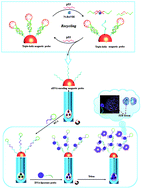Sensitive and selective detection of the p53 gene based on a triple-helix magnetic probe coupled to a fluorescent liposome hybridization assembly via rolling circle amplification†
Abstract
Developing a sensitive and selective sensing platform for the p53 gene and its mutation analysis is essential and may aid in early cancer screening and assessment of prognosis. Here, we developed a highly sensitive and selective p53 gene assay based on the coupling of a triple-helix magnetic probe (THMP) to a fluorescent liposome hybridization assembly, a process initiated by rolling circle amplification (RCA). In the presence of p53, the THMP unfolds and activates an enzymatic cleavage reaction, thus releasing the RCA primer and initiating the RCA product-assisted fluorescent liposome hybridization assembly. The resultant double-stranded DNA structures bind the intercalating SG dye from the fluorescent liposomes, thus dramatically enhancing the fluorescence signal. In the absence of p53, the THMP remains intact and blocks the trigger release and fluorescent liposome assembly, thus resulting in a low background signal. The THMPs were designed with integrated target recognition by Watson–Crick base-pairing, site-specific cleavage by an endonuclease and background signal elimination by magnetic isolation, thus avoiding the need to design multiple probes. Moreover, the use of fluorescent liposome assembly and magnetic isolation helps in avoiding sample matrix interference and nonspecific staining. Through cooperative amplification coupling with enzyme cleavage recycling, the RCA-assisted fluorescent liposome assembly and magnetic isolation improved the sensitivity, with a detection limit of 0.07 fM. The excellent capacity of the THMP to specifically detect the involved targets and the precise site-specific endonuclease cleavage ensured remarkable selectivity for p53 against single-base mismatches. This proposed approach worked well in biological samples, thus demonstrating great potential for biomedical and clinical diagnosis applications.

- This article is part of the themed collection: RSC papers by NanoEngineering for Medicine and Biology 2018 Speakers


 Please wait while we load your content...
Please wait while we load your content...